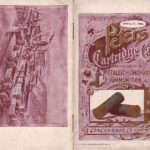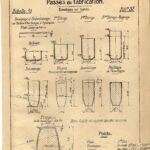Some Early 50-70 Cartridges by the Union Metallic Cartridge Co.
- February 12, 2023
- 7 Min Read
This article was written by Howard Hoovestol and originally published in IAA Journal Issue 490, Mar./Apr. 2013
After several years of collecting and studying the 50-70, I have arrived at some conclusions concerning the early production of the 50-70 cartridge. Most early UMC bullets have a narrow band adjacent to the mouth of the case: the cartridges furnished to commercial outlets have the 450-grain bullet; cartridges and/or bullets furnished to the Sharps Rifle Mfg. Co. have 457-grain bullets, except for the 500-grain bullet which has a smooth patch; cartridges furnished under contract to the War Dept. have the government style 450- grain bullet without the narrow band
The photographs do not show the narrow bands on the bullets as well as expected. Specimens, 3, 4 and 10 have very narrow bands that are barely visible, but they are there.
Specimen No. 1


The case on this one was definitely made at Springfield Armory under improvements to Edwin Martin’s June 8, 1865 patent.[1] It has the four tic-mark pattern on the head which indicates it was more than likely loaded at Springfield. It also has the bar-anvil primer which is crimped in the case as used at Springfield. However, the bullet is 457 grains with the narrow band, typical of UMC bullets. The question is: Did the Spring- field Armory procure bullets from UMC for loading these cartridges?
There is evidence of close cooperation between Springfield Armory and UMC in a letter from UMC to Col. Benton, commanding the Armory, dated June 23, 1868.


UMC asked “Will you please to send us 1,000 new model centre fire cartridges in place of those returned you the other day – we want the kind with inside cup. The order originally thru Messrs. Schuyler, Hartley & Graham of New York” Robt. White, Treas.
A box label for ten of these cartridges is illustrated from the August, 1985 The Gun Report in Figure 1.
Specimen No. 2


This cartridge is very similar to Specimen No. 1. It also has the 457-grain bullet with the narrow band. However, the head of the case has the two tic-mark pattern found on early UMC cartridges, indicating it was loaded at UMC. In 1868 and 1869, the Sharps Rifle Mfg Co. converted 32,184 percussion carbines and rifles to 50-70. On Nov. 7, 1867 James T. Ames, President of the Sharps company had requested cartridges from Springfield for testing the conversions. Over 200,000 cartridges were used from Feb. 1868 to Oct. 1869. It’s obvious specimens 1 and 2 were furnished for these tests.[2]
The 1869 Sharps catalog listed the 457-grain grooved ball and the 500-grain patched ball. Also listed were centre-fire Martin’s copper shells.[3] This same listing was continued in the 1873 Sharps catalog, but not in the 1876 catalog. After this date the 50-70 was available only on special order.
Specimen No. 3

The case for this cartridge was made under Hiram Berdan’s patent of Sept. 29, 1868. It is primed with the primer patented by A. C. Hobbs on Sept. 14, 1869. It is loaded with the 450-grain bullet with the very narrow band. Since it has the 450-grain bullet it was made for commercial outlets. The 450-grain bullet is approximately .04 in. shorter than the 457 grain. It is not as pointed as the 457 grain.
Specimen No. 4

This cartridge is similar to Specimen No. 3. This cartridge is one of the early ones made by UMC who paid royalties to Berdan for many years until the patent ran out several years later. The cartridge is loaded with a 457-grain bullet as listed in the Sharps 1869 and 1873 catalogs. The bullet also has a very narrow band.
Specimen No. 5

One cartridge patent in 1869 that showed great promise was Edwin Martin’s patent of March 23, 1869. Martin was in charge of the cartridge department at Springfield Armory where the cartridge was designed. On May 11, 1869 the partners, Martin, Porter, and Cranston, licensed the Sharps Rifle Mfg Co. to manufacture the Martin cartridge. Sharps in turn licensed Schuyler, Hartley and Graham the right to the patent who arranged with UMC for their manufacture.[4] This specimen is loaded with the

457-grain bullet with the narrow band. It does not have the reentrant fold. It has a slight indentation from a firing pin. (Hurrah for misfires, if it had not misfired, the bullet would have been lost and the case trampled into the dust. A scarce cartridge was thus saved for future collectors.)
Specimen No. 6

Some time in 1870 a reentrant fold was added to the case although Martin did not receive a patent covering this feature until February 14, 1871. This improvement did not strengthen the case as thought, but it did add to the ductility. This specimen has the reentrant fold and is loaded with the 450-grain bullet with the narrow band. Since it was loaded with this bullet it was intended for commercial out- lets.
A box label for this cartridge is illustrated in Figure 2 above.
Specimen No. 7

This cartridge case was made under the Berdan patent and primed with the Hobbs primer. It has the 500-grain paper-patched bullet as listed in the 1869 and 1873 Sharps catalogs. This load was discontinued about 1875 since it is not in the 1876 Sharps cata- log. This cartridge came from a box like the one illustrated in Figure 3.
Specimen No. 8

This cartridge is similar to Specimen No. 7. However, it is loaded with the 450- grain bullet. It is very slightly necked where it was crimped over the bullet. This speci- men is one of those furnished under the let- ter contract for 500,000 between UMC and the Ordnance Dept. dated April 2, 1873.
Guy Hildebrand discovered a wooden packing crate which included 5,000 of these. The cartridges were packed in paper boxes of 50 each.[5] The bullets do not have the narrow band since they were made to government specifications. Inspection was completed on December 24, 1873.[6]
A box label for these cartridges is illustrated in Figure 4.
Specimen No. 9


This cartridge has a folded head, a 450- grain bullet of government style and is primed with a Winchester primer which was later patented by Oliver F. Winchester on July 14, 1874. Fifty-five fired empty cases have been found at the site of the Allen Creek fight which occurred on August 11, 1873, so it’s not an anomaly. A sectioned view of the case is illustrated in a UMC price list of 1873. UMC did not have a primer which would fit this case until 1876. So they evidently procured primers from Winchester to fill a government order. The case has a wide bevel into the primer pocket which helps to identify this cartridge. Further information is avail- able in my article on this unusual cartridge.[7, 8]
Specimen No. 10


This cartridge has a bevelled head and is headstamped “ U.M.C. CO 50-70”. It is loaded with the 450-grain bullet that still has the narrow band. It is primed with the No. 2 brass primer. Interestingly enough, the January 1, 1880 UMC price list notes that the 50-70 government has the A primer (Berdan) but that “some of the 50 Govt have the No. 2 Wesson”. I believe this note in the price list refers to this cartridge. Other bevelled head cartridges were produced by UMC at the same time, 1879 to 1881.

Specimen No. 11

This is the rimfire 50-70. It is loaded with a plain 450- grain bullet with one narrow groove. It was illustrated in the 1869 UMC price list and for many years after that. It was “adapted to Remington’s musket.” Since it has no tics on the head it is not especially early.
This brings us to the beginning of headstamping and the production of 50-70’s with many different loadings. It is time to bring this little article to an end.


Footnotes
1. Martin’s 1865 patent was very impractical but improvements made at Springfield Armory produced a practical design.
2. Sellers, Frank, Sharps Firearms North Hollywood, 1978, p177 and180
3. Ibid. p195 and 230
4. Patent Archives at the Remington Arms Company, Ilion, N.Y. courtesy of Lou Behling
5. Guy Hildebrand website, The Cartridge Collectors Ex- change, Feb, 2004
6. UMC Broadsheet, circa. 1879-1880
7. Hoovestol, Howard, “An Unusual 50-70 Cartridge” St. Louis Cartridge Collectors Newsletter, Vol. 20, No.2
8. Haynes, C. Vance, “.50 Caliber Center Fire Cartridges of the 1873 Yellowstone Expedition”, IAA Journal, No. 484





